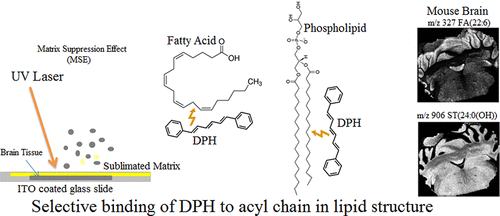当前位置:
X-MOL 学术
›
Anal. Chem.
›
论文详情
Our official English website, www.x-mol.net, welcomes your feedback! (Note: you will need to create a separate account there.)
1,6-Diphenyl-1,3,5-hexatriene (DPH) as a Novel Matrix for MALDI MS Imaging of Fatty Acids, Phospholipids, and Sulfatides in Brain Tissues
Analytical Chemistry ( IF 7.4 ) Pub Date : 2017-11-15 00:00:00 , DOI: 10.1021/acs.analchem.7b03284 Hanadi Ibrahim 1 , Kristina Jurcic 1 , Jasmine S.-H. Wang 1 , Shawn N. Whitehead 1 , Ken K.-C. Yeung 1
Analytical Chemistry ( IF 7.4 ) Pub Date : 2017-11-15 00:00:00 , DOI: 10.1021/acs.analchem.7b03284 Hanadi Ibrahim 1 , Kristina Jurcic 1 , Jasmine S.-H. Wang 1 , Shawn N. Whitehead 1 , Ken K.-C. Yeung 1
Affiliation

|
1,6-Diphenyl-1,3,5-hexatriene (DPH) is a commonly used fluorescence probe for studying cell membrane-lipids due to its affinity toward the acyl chains in the phospholipid bilayers. In this work, we investigated its use in matrix-assisted laser desorption/ionization (MALDI) as a new matrix for mass spectrometry imaging (MSI) of mouse and rat brain tissue. DPH exhibits very minimal matrix-induced background signals for the analysis of small molecules (below m/z of 1000). In the negative ion mode, DPH permits the highly sensitive detection of small fatty acids (m/z 200–350) as well as a variety of large lipids up to m/z of 1000, including lyso-phospholipid, phosphatidic acid (PA), phosphoethanolamine (PE), phosphatidylserine (PS), phosphatidylglycerol (PG), phosphatidylinositol (PI), and sulfatides (ST). The analytes were mostly detected as the deprotonated ion [M – H]−. Our results also demonstrate that sublimated DPH is stable for at least 24 h under the vacuum of our MALDI mass spectrometer. The ability to apply DPH via sublimation coupled with its low volatility allows us to perform tissue imaging of the above analytes at high spatial resolution. The degree of lipid fragmentation was determined experimentally at varying laser intensities. The results illustrated that the use of relatively low laser energy is important to minimize the artificially generated fatty acid signals. On the other hand, the lipid fragmentation obtained at higher laser energies provided tandem MS information useful for lipid structure elucidation.
中文翻译:

1,6-二苯基-1,3,5-己三烯(DPH)作为新型基质用于脑组织中脂肪酸,磷脂和硫化物的MALDI MS成像
1,6-二苯基-1,3,5-己三烯(DPH)是研究细胞膜脂质的常用荧光探针,因为它对磷脂双层中的酰基链具有亲和力。在这项工作中,我们调查了其在基质辅助激光解吸/电离(MALDI)中的使用,作为小鼠和大鼠脑组织质谱成像(MSI)的新基质。DPH在分析小分子(m / z低于1000)时表现出极少的基质诱导的背景信号。在负离子模式下,DPH可以高度灵敏地检测小脂肪酸(m / z 200–350)以及各种大脂质,直至m / z每1000个样本中有1个,包括溶血磷脂,磷脂酸(PA),磷乙醇胺(PE),磷脂酰丝氨酸(PS),磷脂酰甘油(PG),磷脂酰肌醇(PI)和硫酸酯(ST)。分析物主要被检测为去质子离子[M – H] -。我们的结果还表明,在我们的MALDI质谱仪的真空下,升华的DPH至少可以稳定24小时。通过升华应用DPH的能力及其低挥发性使我们能够以高空间分辨率对上述分析物进行组织成像。在不同的激光强度下通过实验确定脂质碎片的程度。结果表明,使用相对较低的激光能量对于最小化人工生成的脂肪酸信号很重要。另一方面,在较高的激光能量下获得的脂质碎片提供了串联MS信息,可用于阐明脂质结构。
更新日期:2017-11-16
中文翻译:

1,6-二苯基-1,3,5-己三烯(DPH)作为新型基质用于脑组织中脂肪酸,磷脂和硫化物的MALDI MS成像
1,6-二苯基-1,3,5-己三烯(DPH)是研究细胞膜脂质的常用荧光探针,因为它对磷脂双层中的酰基链具有亲和力。在这项工作中,我们调查了其在基质辅助激光解吸/电离(MALDI)中的使用,作为小鼠和大鼠脑组织质谱成像(MSI)的新基质。DPH在分析小分子(m / z低于1000)时表现出极少的基质诱导的背景信号。在负离子模式下,DPH可以高度灵敏地检测小脂肪酸(m / z 200–350)以及各种大脂质,直至m / z每1000个样本中有1个,包括溶血磷脂,磷脂酸(PA),磷乙醇胺(PE),磷脂酰丝氨酸(PS),磷脂酰甘油(PG),磷脂酰肌醇(PI)和硫酸酯(ST)。分析物主要被检测为去质子离子[M – H] -。我们的结果还表明,在我们的MALDI质谱仪的真空下,升华的DPH至少可以稳定24小时。通过升华应用DPH的能力及其低挥发性使我们能够以高空间分辨率对上述分析物进行组织成像。在不同的激光强度下通过实验确定脂质碎片的程度。结果表明,使用相对较低的激光能量对于最小化人工生成的脂肪酸信号很重要。另一方面,在较高的激光能量下获得的脂质碎片提供了串联MS信息,可用于阐明脂质结构。



























 京公网安备 11010802027423号
京公网安备 11010802027423号